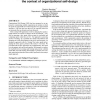Free Online Productivity Tools
i2Speak
i2Symbol
i2OCR
iTex2Img
iWeb2Print
iWeb2Shot
i2Type
iPdf2Split
iPdf2Merge
i2Bopomofo
i2Arabic
i2Style
i2Image
i2PDF
iLatex2Rtf
Sci2ools
ATAL
2009
Springer
2009
Springer
Analyzing the tradeoffs between breakup and cloning in the context of organizational self-design
Organizational Self-Design (OSD) has been proposed as an approach to constructing suitable organizations at runtime in which the agents are responsible for constructing their own organizational structures. OSD has also been shown to be especially suited for environments that are dynamic and semi-dynamic. Most existing OSD approaches work by changing the organizational structure in response to changes in the environment — usually by spawning a new agent when an agent is overloaded and composing agents when they are free. One approach to spawning involves "breaking" up a problem into smaller sub-problems and assigning one of the sub-problems to the newly spawned agent. An alternative approach works by "cloning" the source agent and assigning the clone agent a portion of the source’s work load. We posit that both of these approaches are complementary, have their own advantages, and can be used together. In this paper we analyze the tradeoffs between cloning and br...
Artificial Intelligence | ATAL 2009 | Organizational Structure | OSD Approaches | Suitable Organizations |
| Added | 26 May 2010 |
| Updated | 26 May 2010 |
| Type | Conference |
| Year | 2009 |
| Where | ATAL |
| Authors | Sachin Kamboj |
Comments (0)

